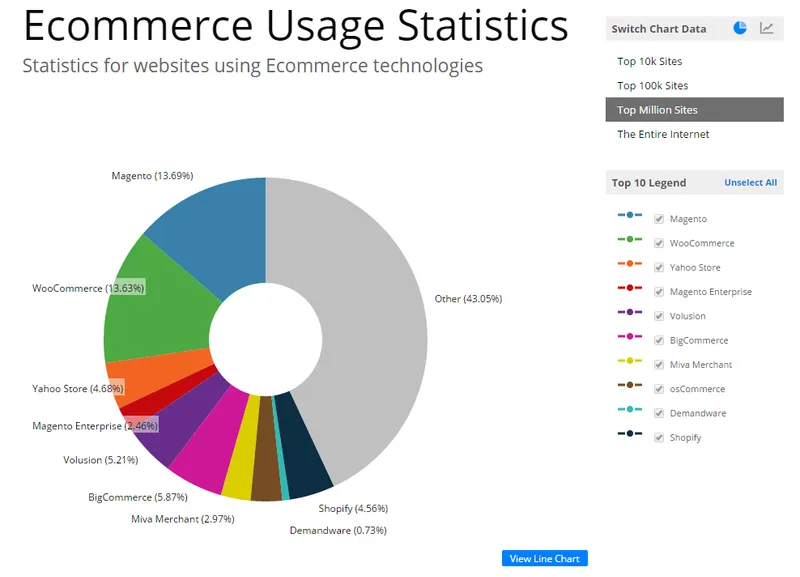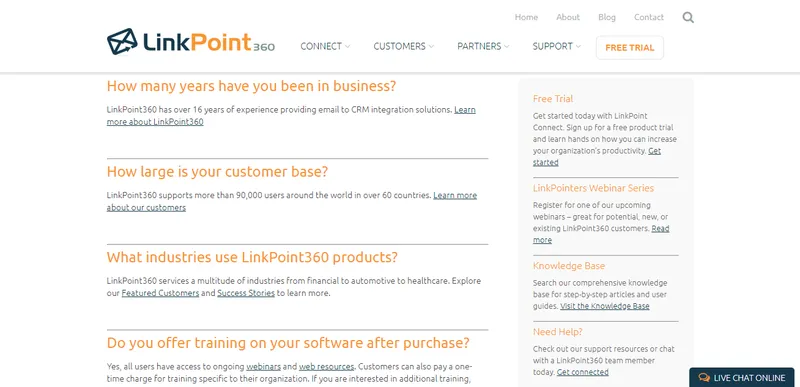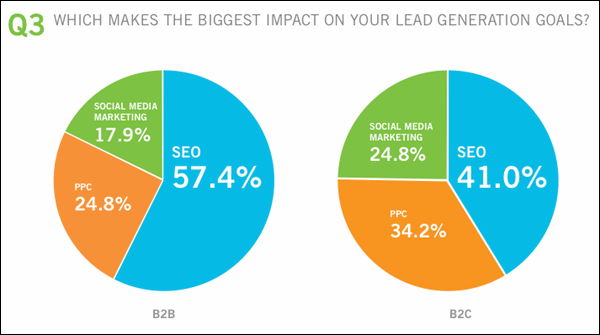

9 B2B eCommerce strategies that increase your sales
B2B companies must consider digital transformation to increase sales. Look at 9 B2B eCommerce strategies for your business growth.
According to Forrester Research, B2B eCommerce sales in the US reached $1 trillion in the year 2018. Over the next five years, B2B eCommerce sales are expected to grow at a rate of 10%. The industry is growing quickly. Vendors need to develop new B2B eCommerce strategies to stay relevant and keep growing.
To outperform other vendors, you’ll need long-term growth planning, understand B2B buyer mindset, develop new relationship-building tactics. Let’s have a look at the challenges faced by B2B eCommerce business owners and explore the top 9 B2B eCommerce strategies to scale up your business.
1) Choose a technology platform that meets your requirements
There are more than ten eCommerce platforms available in the market. As per the chart published by Seeking Alpha, many eCommerce B2B vendors choose from the top 5 platforms. From the top 1 million, 13.69% of sites are using Magento, 13.63% sites use WooCommerce, and 5.87% sites have chosen BigCommerce.

https://static.seekingalpha.com/uploads/2014/9/22/23106453-14114124526899166-David-Hernandez_origin.png
Before you start selecting your platform, you should document your business requirements, technology needs, and list of features you should provide to your buyers. Once the document is ready, compare it with the features offered by the top 5 eCommerce platforms.
Whichever is meeting your requirements the most, go with that one. This will minimize the additional development and modifications you will need to do. It will save your time, efforts, and money.
2) Provide excellent UX and beautiful UI
Excellent user experience and appealing user interface are critical technology factors when it comes to the success of your B2B eCommerce strategies. If your platform is difficult to navigate or confusing to use, buyers are unlikely to revisit it.
In such cases, the inbound lead generation capabilities will be negatively impacted, and you may lose a lot of potential customers. Understand the user persona you are dealing with, their needs, and pain points. Take note of their requirements and what problems they are facing. Build UX/UI deep focused on customer problems, their persona, and needs.
3) Write compelling but visual product description
Be it a B2C customer or a B2B buyer, product description matters a lot. According to a Salesforce report, 59% of B2B buyers conduct online research themselves. They want objective information rather than reading promotional content.

https://thealmanac.org/g/019-product-sell-sheet-template-word-ideas-solo-858x1280.jpg
For higher B2B sales, you need to create a compelling product description that answers the challenges of your customer base. When you are creating content, focus on the unique needs and concerns of your customers.
Visual content has the highest impact on the readers' mindset. Besides, create the Amazon effect; integrate product reviews into your B2B eCommerce platform. Also, implement key up-sell and cross-sell functionality within your B2B eCommerce strategies.
4) Create buyer-focused FAQs and highlight it
When a wholesaler is making a purchase decision, he or she may have a lot of queries in mind. Many product companies create FAQs based on features, specifications, requirements, and usage. Those are useful but not enough.

Create buyer-focused FAQs which tries to address future problems your buyers will face. Having an extensive list of questions improves customer experience, conversions, and your website SEO score. Besides, it also reduces the time and money spent on customer support.
5) Utilize the power of SEO
According to Search Engine Land, 57.4% of the B2B marketers consider SEO as their primary source of lead generation, which is even higher compared to B2C. As per a report by Fronetics, 62% of B2B buyers do a web search while they are making a purchase decision.

https://searchengineland.com/seo-beats-ppc-social-media-for-generating-leads-99064
Furthermore, 71% of these searches start with generic non-branded terms and not with the name of a company. Hence, you need to move out of your space and create content for the most relevant and most common words your audience is searching for.
If your company is not present on top search results, your potential customer is now in the hands of your competitors. If you haven’t done SEO to date, start with basics of technical SEO such as sitemap, interlinking patterns, and optimize website loading speed.
6) Implement social media marketing
If you think that social media platforms, especially Facebook, is not for B2B clients, let’s break the myth. According to Articulate Marketing, 84% of decision-makers are influenced by social media when making a purchase decision. As per the statistics, 43% of the companies acquired a customer through Facebook.

https://www.articulatemarketing.com/blog/b2b-social-media-statistics
65% of B2B companies acquired customers using LinkedIn. B2B buyers use social media to get recommendations and suggestions from other users. To improve B2B sales, make social marketing an essential part of your B2B eCommerce marketing strategies. Create some impactful social media marketing campaigns that boost engagement and conversions.
7) Simplify the transaction process
Be it a B2B wholesaler or B2C buyer; they want the payment process to quick, easy and straightforward. When a B2B buyer is at the purchase screen or about to make a payment, they are sure to do business with you. In a worst-case scenario, a complicated payment process may result in an abandoned cart.
To simplify the payment process, make your payment form short. Only ask for four essential details. You can ask the rest of the details before they see a payment screen or in the personal information or shipping details form.
To make the payment easier for your customers, use a payment gateway that supports the most type of payment method. For international sales, you can use Stripe or PayPal.
8) Optimize the delivery process
Optimize your supply chain and shipping processes to ensure faster delivery. Businesses buy from you so that they can sell to their customers. If your delivery process is quicker and efficient, it will make the entire business-cycle faster. They will be able to fulfill their customer demands quickly. Provide an effective tracking mechanism, as well.
When you enable quicker delivery and better tracking, it delights them and improves customer experience. Buyers are likely to purchase from you instead of your competitors when you are providing faster delivery and better tracking, even at a marginally higher cost.
9) Enhance before and after sales services
According to a report published by LinkedIn, trust, personal relationship, responsiveness, quality improvements and value for money the most important factors for a strong relationship with your buyer. Buyers expect the vendor to score high in these five aspects before they make a purchase, and even after they’ve made the purchase.

When it comes to before sales, your salesperson should be able to answer most of the queries and concerns raised by the potential buyer including technical ones. Offer and showcase them quality improvements compared to their existing solutions.
This will help you build their trust in you. When it comes to after-sales, focus on quick customer support and technical support. Besides, maintain an excellent personal relationship with the key decision-maker. It will immensely help you in repeat business.
Right B2B eCommerce strategies will lead to exponential growth
Rock-solid B2B eCommerce strategies will result in exponential business growth in the long term. Talking about growth, the market size of the B2B eCommerce market is expected to cross $1.1 trillion in the year 2021. Less than 50% of B2B companies had an e-commerce site but it is expected to reach 70% in the next two years.

https://www.digitalcommerce360.com/2018/07/30/infographic-b2b-e-commerce-by-the-numbers/
Arriving at impactful and effective B2B eCommerce strategies isn’t easy. You will need to be disciplined in your execution and patient in seeing the outcomes. However, once you have mastered what works for your business, it will pay dividends that are exponentially greater than the investment made.






![Top 10 Cheap Indian Press Release Distribution Services [Updated]](https://images.yourstory.com/cs/1/b3c72b9bab5e11e88691f70342131e20/LOGO-DESIGN-PR-INDIA-WIRE-03-1595693999405.png?mode=crop&crop=faces&ar=1%3A1&format=auto&w=1920&q=75)
